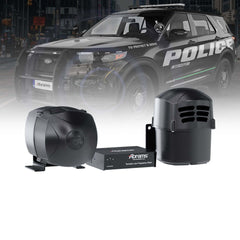LED Emergency Vehicle Lights Are The Better Choice!
Emergency vehicle lights serve an important safety function by alerting drivers to potential danger ahead. It also ensures that an emergency vehicle responds safely and quickly to the location. Unfortunately, for some, installing emergency vehicle lights is just another expense.
On the other hand, a short-sighted approach can jeopardize safety. And if you are still adhering to low-performance lights, then you might need to reconsider. They are unreliable, high-maintenance products, resulting in a much higher long-term cost than what it appears at first.
What To Look For In The Lights For Emergency Vehicles?
The light source should be the most important consideration when designing a light bar, directional warning light, or beacon.
- While halogen lamps are inexpensive, their lifespan is limited to around 2000 hours. It can equate to only a few months in applications where emergency vehicle lights are used for extended periods.
- A strobe light source is an alternative here; strobes are much more powerful than halogen sources which also aid in reducing maintenance and noise. However, light source life is limited, and strobe technology consumes a lot of power.
- The final and most popular option is to use LED technology. LEDs can be used to generate light in a variety of colors, including white, blue, and red.
Why Are LED Emergency Vehicle Lights The Supreme Choice?
The most important advantage of LED emergency vehicle warning lights is their long working life. The latest generation LED technology has a life of 50,000 hours, which is many times that of a halogen source, allowing maintenance intervals of many years rather than a few months.
- LEDs can be switched on and off quickly without affecting their life, allowing for silent operation with a variety of flash patterns.
- When considering LED emergency vehicle warning lights, it is critical to select high-quality products. Previous generation LEDs have a significantly shorter lifespan than current generation LEDs (typically less than half of a good quality current generation product).
- LEDs can produce many times more light than traditional products and have a significantly longer life.
- However, the drive circuitry's quality and the LED chips' thermal management significantly impact both light output and LED life.
Technology With Multiple Colors:
Another advantage of LED emergency vehicle warning lights over halogen, and strobe alternatives is that it produces colored light rather than white light and relies on colored lenses to produce the desired final light color.
- LED technology can generate the required light color from the start, allowing clear lenses to be used.
- Color shift LED emergency vehicle warning lights have been around for a while. This technology typically employs several different color LEDs, typically red, green, and blue, which are all mounted on a single tiny chip.
- While this technique is ideal for many applications, it has not been widely used for emergency warning lighting in the past few years.
Other applications for multi-color technology include having lights change color based on the situation. For example, on a lightbar, when the vehicle is on, all lights can flash blue for maximum warning impact, but when the vehicle arrives at the incident, some lights can change color and flash red.
LED Emergency Vehicle Lights, The Choice Of The Evolved
Previously, halogens were used in emergency lighting. However, those were not the ideal choices for vehicle-based applications.
- Halogen lights consume a lot of energy, are inefficient, and have a short lifespan. Whereas discharge lighting is much more efficient but has long warm-up times and is difficult to control optically.
- LEDs are more efficient than halogen bulbs, producing more light while consuming less power. Furthermore, LEDs operate with long life and tough design, making LED warning lights for emergency vehicles the preferred choice for vehicle interior lighting and scene lighting.
In A Nutshell
LED warning lights for emergency vehicles are increasingly being used in a variety of applications on modern vehicles, owing to the combination of long life, silent operation, low power consumption, and slimline design.
While LED warning light bars have a higher initial cost, the long-term maintenance and energy savings make them an increasingly popular choice for many vehicle applications. Furthermore, LED warning light bars are evolving, opening up new possibilities for warning and scene lighting.


